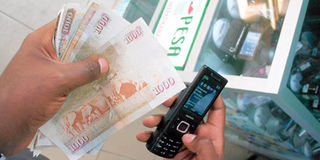How technology is breaking barriers to growth

Photo/FILE
Mobile money transfer began in Kenya with the roll-out of Safaricom’s M-Pesa service in 2007.
What you need to know:
- Yet M-Pesa processes an average of more than six mobile loans every second.
- Today, more than 500,000 Kenyans are saving on their mobile phones through M-Tiba, enabling them to access life-saving treatment at more than 300 facilities.
Commodities have shaped the history of Africa – defining its borders, building its talent pool and shaping its policies.
Traditionally, three African economies – Angola, Nigeria and South Africa – have represented about 40 per cent of the continent’s Gross Domestic Product.
These economies now face major challenges occasioned by today’s complex global environment.
Last year, these economies hit new lows of between 0.4 and -1.7 per cent compared to their 16-year average of 6.9 per cent.
The good news is: African economies have a new opportunity to diversify their income by exploring new areas of growth.
YOUNGER POPULATIONS
Kenya, Burkina Faso, and Senegal have recorded GDP growth rate increases, rising from about 5 per cent in 2015 to about 6 per cent in 2016.
Cote d'Ivoire is set to record an 8 per cent growth rate in 2016, the highest in sub-Saharan Africa.
They are pegging their growth on their relatively younger populations, diversified economic activity, and the impact of enhanced trade opportunities.
It’s already apparent that we have the building blocks for a new life for Africa.
The connective tissue that will build a new Africa lies in meeting the needs of the people. And that is what we at Safaricom we are working to do in Kenya.
The mobile phone has become a tool connecting more than 23 million Kenyans to essential services such as banking, security, education, and even health.
BANK ACCOUNT
More than 10.3 million transactions happen on M-Pesa every day. Two-thirds of our M-Pesa users have never had a bank account.
Yet M-Pesa processes an average of more than six mobile loans every second. Financial inclusion in Kenya has grown three-fold in the last seven years.
Technology is also impacting healthcare.
Two out of every five Kenyans who need healthcare services will not seek treatment because they lack money. Nearly half of all healthcare expenditures are paid for out-of-pocket.
This burden is most often carried by low income Kenyans – with poor mothers and young children being particularly vulnerable.
With over 25 million Kenyans able to access a mobile phone, the device has the capability to extend the reach of services that would not be traditionally available.
LIFE-SAVING TREATMENT
Today, more than 500,000 Kenyans are saving on their mobile phones through M-Tiba, enabling them to access life-saving treatment at more than 300 facilities.
This is what “Made in Africa” really means. Such solutions can greatly support socio-economic growth.
Africa is uniquely positioned to seize the moment due to our willingness to embrace and adapt new technologies.
The prize Africa is aiming for is a $405 billion mobile money market by 2025, according to the latest global forecasts. We are making good progress.
Last month, Kenya became the first country in the world to offer a Government bond via the mobile phone.
DONOR FUNDING
Kenyans raised over $1.4 million in three weeks in an initial trial of the service, offering an alternative to traditional dependence on taxes or donor funding.
The big problem with Africa though is a malignant cancer affecting its cells. That cancer is corruption.
It distorts economies and restricts the benefits of growth to a privileged few.
According to a new Pew Research Centre survey in Kenya, South Africa and Nigeria, corruption forms a major public concern.
This is where technology can help break long held barriers to growth. In Kenya, M-Pesa is already helping the government streamline its revenue collection.
ONLINE PLATFORM
Citizens can currently apply and pay for 41 services from various public sector departments, including immigration, civil and business registration, through the eCitizen online platform.
In Niger, the government’s social cash transfer programme was digitised via mobile money in 2010. It now saves beneficiaries time and travel costs, and has helped reduce the government’s administrative costs by 20 per cent.
Rwanda’s e-government platform, Irembo, has reduced the time to complete a birth registration from more than six hours to as little as 40 minutes.
In Tanzania, tapping into mobile telephony, it now takes less than an hour to renew driving licences.
In Côte d’Ivoire, a public-private collaboration between the Ministry of Education and mobile money has resulted in 99.3 per cent of secondary school fees being digitised.
LOST PAYMENTS
This has decreased the number of lost payments, fraud, and theft, and enabled the ministry of Education to better manage their annual budgets because mobile money allowed the government to collect fees earlier in the year. There are numerous other examples.
As we have seen with M-Pesa, the net effect of these solutions is often three times the actual financial returns that mobile money solutions can offer.
A recent McKinsey study has found that governments could gain as much as $110 billion per year in emerging markets by digitising payments and reducing leakage in tax collection and public spending.
These types of technological innovations are the great potential that “Made in Africa” holds for the continent in an increasingly complex world.
Mr Collymore is the CEO, Safaricom. This is an abridged version of a speech he delivered at London Business School Africa Business Summit





